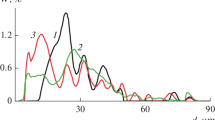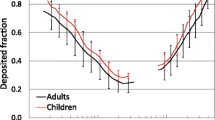Abstract
From an analysis of the fate of the light air ions it was concluded that the most effective mechanism of deposition is the diffusion depriving the inhaled air of light ions at the level of intrasegmental bronchi and bronchioles. A natural electrostatic filter exists in the isthmus faucium.This filter influences the retention of light air ions during mouth-breathing. The electrostatic filter acts on electrically charged particles such as microbes as shown by an investigation of the density of microflora. An increase of the ion retention rate,although quite high in comparison with the same condition in the absence of an electric field,does not radically change the whole deposition pattern. However, a permanent supply of the opposite charge to the electrodes of the natural electrostatic filter may be of some importance to mouth-breathers.
Zusammenfassung
Es wurde das Schicksal der leichten Luftionen mit dem Ergebnis analysiert, dass der wirksamste Mechanismus der Ablagerung die Diffusion ist, durch die sich die inhalierte Luft mit leichten Ionen in der Höhe der Bronchien und Bronchiolen absetzt. Ein natürliches elektrostatisches Filter existiert in Form des isthmus faucium. Dieses Filter beeinflusst das Zurückhalten leichter Luftionen während der Mundatmung. Das elektrostatische Filter wirkt auf die elektrisch geladenen Teilchen wie Mikroben, wie man sie bei einer Untersuchung über die Dichte der Mikroflora beobachtet hat. Eine verstärkte Zurückhaltung der Ionen,obwohl sie im Vergleich zu denselben Bedingungen ohne elektrisches Feld recht hoch ist, ändert den ganzen Ablagerungsmechanismus nicht. Jedoch mag eine dauernde Zufuhr der den Elektoden des natürlichen elektrostatischen Filters entgegengesetzten Ladung von einiger Bedeutung für die Mundatmung sein.
Resume
On a analysé la destinée des ions légers de l'air.Il en découle que le mécanisme le plus efficace de déposition réside dans la diffusion qui prive l'air de ses ions légers au niveau des bronches et des bronchioles.Un filtre électrostatique naturel se trouve dans l'isthmus faucium. Ce filtre influence la rétention des ions légers de l'air durant la respiration par la bouche. Ce filtre électrostatique agit sur les particules chargées électriquement telles que les microbes,comme il découle de recherches effectuées sur la densité de la micro-flore. Un accroissement du taux de retenue des ions, même s il reste élevé en comparaison de ce qui se passe dans des conditions analogues mais en l'absence d'un champ électrique,ne modifie pas radicalement le mécanisme de sédimentation. Pourtant, un apport permanent de charges opposées aux électrodes du filtre électrostatique naturel peut avoir une certaine importance pour les individus respirant par la bouche.
Similar content being viewed by others
References
DAVIES, C.N. (1961): A formalized anatomy of the human respiratory tract. In: Inhaled Particles and Vapours. C.N.Davies (ed.),Pergamon Press, Oxford, 82–87.
FUKS, N.A. (1955): Mechanics of Aerosols (in Russian). Izdat.Ak.nauk, Moscow, pp. 104, 185.
FUKS, N.A. (1961): Advances in Mechanics of Aerosols (in Russian).Izdat.Ak. nauk, Moscow, 73–77.
KORNBLUEH, I.H. and GRIFFIN, J.E. (1955): Artificial air ionization in physical medicine. Amer.J.phys.Med., 34: 618–631.
LATMANIZOVA, L.V. (1959): Intracellular potentials from epithelial tissue (in Russian). Fiziol.zhurn. SSSR, 45: 710–715.
PAVLÍK, I. (1963): The electrostatic filter of the Waldeyer-Pirogov ring(in Czech.). Čs.fysiol., 12: 194–195.
PAVLÍK, I. (1964): Effect of the bioelectric potential of the mucosa of the upper respiratory and alimentary pathways on the distribution of microflora (in Czech). Čs.otolar.,13:204–206.
SELYE, H. (1950): The Physiology and Pathology of Exposure to Stress. Acta Inc., Montreal, 771–772.
THOMAS, J. (1964): A method for calculation of the absorbed dose to the epithelium of the respiratory tract after inhalation of daughter products of radon. Ann.occup.Hyg., 7: 271–284.
VASILJEV, L.L. (1951): Theory and practice of treatment with ionized air(in Russian). Izdat.len.gos.univ.im.Zhdanova, Leningrad, pp.104.
Author information
Authors and Affiliations
Rights and permissions
About this article
Cite this article
Pavlik, I. The fate of light air ions in the respiratory pathways. Int J Biometeorol 11, 175–185 (1967). https://doi.org/10.1007/BF01426844
Issue Date:
DOI: https://doi.org/10.1007/BF01426844




